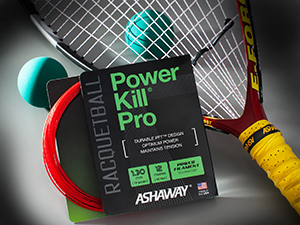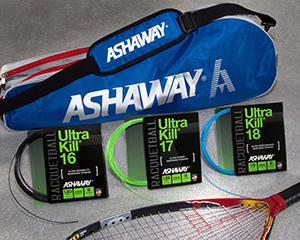|
|

Zyex® String Designs and You
By Steve Crandall
Vice President, Sales & Marketing
Ashaway Racket Strings


We continue to experiment with Zyex and hope to offer even more performance options in the future. But for now, there are two Zyex choices for racquetball. If you like the feel of nylon, but would like more power and better tension holding, try a PowerKill string. If you like the power and feel of unbridled Zyex, go with an UltraKill model. |
In this and the next column we're doing for the winter issue, I'd like to connect the dots between the two major raw materials used in racquetball strings - nylon and Zyex® - and the performance of the string designs that result. Think of it as a kind of 'what can you do for me?' overview of the plusses and minuses of the materials, the ways we are able to use them, and what they may (or may not) do for you when you put them in your racquet. We'll start with Zyex.
Zyex is the trade name for a high temperature, engineering grade polymer known as polyetheretherketone, polyketone or just PEEK. Polyketone materials like Zyex have several physical properties of interest to manufacturers. PEEK monofilaments and fibers are very tough and durable, and have excellent abrasion resistance. In tests measuring "thread on thread" abrasion conducted at room temperature, PEEK multifilaments outlasted aramid fibers by a factor of approximately 5.5. PEEK also has very low moisture uptake at 0.1%, which means you don't need to worry about carrying your racquets around in thunderstorms!
Polyketones are used in a growing range of industrial applications from electrical insulation for aerospace, automotive and nuclear installation wiring to precision filters for fuel or clean air systems. One of the most interesting applications for Zyex-other than racquet strings, of course-is strings for violins, guitars and other musical instruments. Zyex provides a subtle but appreciably fuller tone than other synthetic string materials such as nylon. It also stays in tune much longer. So when users of Ashaway's UltraKill® strings say they love the sound their Zyex strings make, they have good reason.
The property that makes Zyex so good for racquet strings is its low dynamic stiffness, which allows them to stretch and recover more completely than other synthetic materials. This generates power with low impact shock (soft power). Zyex can also be made to have exceptionally low creep under continuous tension, allowing racquet strings to maintain tension and playability longer.
We've experimented with Zyex in a number of different ways in designing racquet strings for racquetball, squash, tennis and badminton. Some work well in some sports but not in others, some do work well in all, and others, well, not so much anywhere-but we don't sell those!
Zyex monofilaments, for example, work very well in tennis, generating exceptional power and spin without the bone-jarring shock of poly or copoly monofilament. They do not have the durability to work well in racquetball, however, even though racquetball balls are lighter than tennis balls (approximately 40 oz. to 58 oz.). There are many more off-center hits in racquetball and the monofilament strings we tried simply didn't have enough sheer strength. Zyex monofilaments were also too lively with the lighter racquetball balls (and squash balls), causing a loss of control.
A core combination that works very well with squash strings is one we dubbed "multi-stranded monofilament." This core uses several smaller Zyex monofilaments twisted together and wrapped in a woven jacket. But again-mainly because of the new 'power racquet' designs and off-the-wall stringing patterns in racquetball - this core combination doesn't work with our sport.
But there are two combinations that do work very well in racquetball strings. One is the standard multifilament construction used in our UltraKill family of strings. Multifilament construction adds sheer strength to the core (which makes stringing much easier) and reduces the liveliness of the strings just enough to provide optimum power and control. The 17 gauge version provides superior power and durability, while the 18 gauge version provides a bit more feel. Both offer exceptional tension retention.
The final-and most recent-way we have experimented with Zyex fibers is in the jacket or wear layer. Jackets are designed to hold core packages together, increase abrasion resistance and sometimes add surface texture to increase bite on the ball. However, when we tried weaving Zyex fibers into jacket constructions, we found they enhanced performance characteristics as well.
So good was this new construction, in fact, that we trademarked it as PFTTM (Power Filament Technology) and built our new PowerKill® family around it. The PFT jackets on the multifilament nylon core of PowerKill strings add power (soft power), improve tension holding, and increase string durability. What you get, in effect, is a nylon-based string with superpower, i.e., Zyex power.
We continue to experiment with Zyex and hope to offer even more performance options in the future. But for now, there are two Zyex choices for racquetball. If you like the feel of nylon, but would like more power and better tension holding, try a PowerKill string. If you like the power and feel of unbridled Zyex, go with an UltraKill model.
ZYEX® is a registered trademark of Victrex Ltd.
|